The RISM series, Écrits imprimés concernant la Musique, two volumes containing the location of all known theoretical works of music dating from late-fifteenth-century incunables to printed books of the late eighteenth century, was published in 1971. These volumes have not yet been digitized, a process that would have allowed for the inclusion of recently discovered sources. One of these is a copy of the music book, Erotemata musices by Ambrosius Wilfflingseder, published by Christoph Heussler in Nuremberg in 1563, extant in nineteen copies as of 1971.
A few years ago, the Special Collections department of the Sheridan Libraries at the Johns Hopkins University purchased a copy of the Erotemata for my teaching and ongoing research on images and symbols of musical learning in the early modern era. This copy, the twentieth known copy of Wilfflingseder’s text, is now housed in its magnificent George Peabody Library. Apart from this copy, IMSLP has digitized the Munich copy of this music text in octavo format with nearly 400 pages of music and text intended for the students at St Sebald’s School in Nuremberg in 1563, Wilfflingseder’s Erotemata contains what we now believe are the earliest examples of volvelles in a music text.

Volvelles (from the Latin volvere, to turn) are interactive wheel charts inserted in manuscripts and printed books as mnemonic aids for learning a variety of subjects. They had been present in medieval manuscripts beginning in the thirteenth century in works as diverse as Ramon Llull’s Ars Magna and Matthew Paris’s Chronica Majora, Corpus Christi College, Cambridge.[1]
These ‘pop-ups’—similar to analog computers— are not only visual enticements but also pedagogical aids giving students an extra opportunity to engage in learning both visually in 2D and kinesthetically in 3D. Each of these devices are paper versions of sundials and astrolabes and other ivory and metal instruments used for a variety of computational purposes. Readers of these paper ‘substitutes’ for the actual instruments, in a variety of disciplines— from astronomy, astrology (the zodiac), computation, calendrical calculations, cryptography, navigation, and architecture— are able to absorb technical information in a variety of ways.
Daniel Muzzulini and Michael Dodds have been engaged in research on volvelles in particular as they relate to circularity in music, but their examples date from at least sixty years after the Wilfflingseder publication. Dodds believed that the earliest example appeared in the Arte de Musica (Lisbon, 1626) by the Portuguese theorist Antonio Fernandez. This volvelle was capable of revealing by a turn of the wheel transpositions of intervals to any key in the circle of fifths. Dodds originally hypothesized that books containing volvelles were associated with important navigational centers, such as busy ports along the Atlantic and Mediterranean. [2]
The volvelles were an added attraction in that they were symbolic of steering wheels and allowed for virtual navigation. In recent papers presented at the American Musicological Society, at the Schulich School of Music at McGill University, and at the 47th Annual Medieval and Renaissance Music Conference at the Schola Cantorum in Basel, I argue that musical volvelles did appear before 17th-century and were not necessarily associated with seaports and regions close to navigational centers. [3] In fact, many of the late fifteenth and sixteenth century texts containing astronomical, calendrical and navigational volvelles were published in Nuremberg.
This past semester, in a graduate musicology seminar at Princeton, one of my students with an interest in early printed books focused on architecture and acoustics chose to study Daniele Barbaro’s translation of Vitruvius De Architectura (Venice: Francesco Marcolini, 1556), one with illustrations designed in part by Andrea Palladio (1508–1580). It is said to be the first architectural work to employ flaps, extensions or volvelles, three of the latter. These interactive paper computers signal a transition from the linear into spatial dimensions, to simulate realistic visual representation, in contrast to the ‘flatness’ seen in earlier images. In the chapter on the acoustics of a room, other 16th century editions of this treatise contain one of the most common ‘flat’ symbols of musical learning, the so-called Guidonian hand, an image that is part of my ongoing research on the materiality of music pedagogy in the Renaissance.[4]
One other peripheral but significant connection between volvelles and music is one that appears in a calendrical work by the 16th-century well-known music theorist Gioseffo Zarlino, his De Vera Anni Forma: Sive De Recta Eius Emendatione (Venice: Giovanni Varisco,1580). All of this confirms the notion that these interactive devices were more common than once thought. That the only surviving sixteenth-century musical volvelle is the set in the text by Ambrosius Wilfflingseder is a question worth pursuing.
Ambrosius Wilfflingseder was a schoolmaster and Kantor at St. Sebaldus in Nuremberg, where he lived and worked. Nuremberg was a thriving mercantile center, that lay on active routes and established itself as an important manufacturer of metal ware. According to Penny Gouk, Nuremberg’s reputation for making quality products, such as compasses, ivory sundials and musical instruments, spread throughout Europe, and many attended the several trade fairs held there each year. [5] The astronomer Johannes Müller, called “Regiomontanus” settled in the city in 1471, setting up a workshop and a printing press for the production for scientific instruments and books, further enhancing Nuremberg’s reputation as a center for learning the subjects of the quadrivium. One of the earliest volvelles to appear in a Calendarium, a book printed on Regiomontanus’ private press in Nuremberg in 1474 and it is no surprise that among the books in Regiomontanus’ library was a manuscript copy of Llull’s works that describe the use of volvelles. In 1476 in Venice Erhard Ratdolt published more elaborate versions of Regiomontanus’ volvelles.
Wilfflingseder’s Erotemata is essentially a regulation music textbook of the variety found in German-speaking lands in the 16th century. Another music text with the same title by Luca Lossius was published in Nuremberg in the same year by the well-known firm of Montanus and Neuber. There are no volvelles in the Lossius text, but in other aspects the materials resemble the question and answer format used by Wilfflingseder. Apart from a standard introduction with some historical background on the origins of music with quotations from the bible and classical authors, with sprinklings of Greek and Hebrew text, the customary questions in dialogue format regarding the rules of music theory, the book is filled with music by some of the more illustrious composers of Josquin’s generation. Still, the most interesting aspect of the volume are the four volvelles. The first provides the reader with an interactive tool to enhance the understanding of the hexachord system as shown in chart on the facing page. and three others as companions to text on the rules of ligatures of and elements of mensural notation.
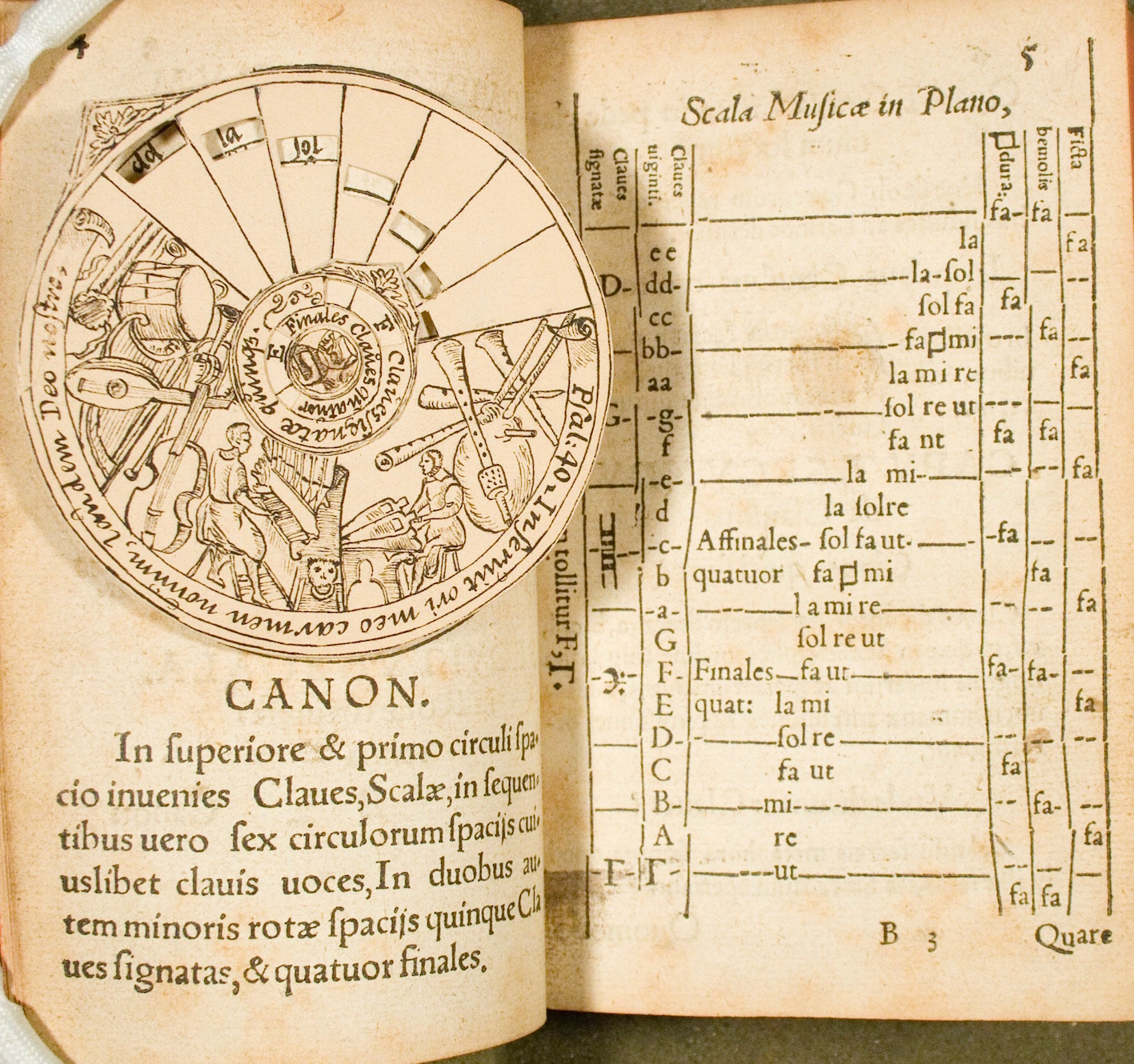
There are various ways in which to view it, thanks to multiple copies scattered around the US and Europe. One can see it as it appears in the book, or as taken apart: the base, the larger disc and the smaller one.

What follows are 20 rotations of the wheel (courtesy of a copy in the NYPL).

The second volvelle on p. 137 is an aid to Chapter 4 “Quid est ligature,” the rules for the ligatures. The cover is missing in the Baltimore copy, but present in thirteen frames in the IMSLP Munich copy, enabling an animation.

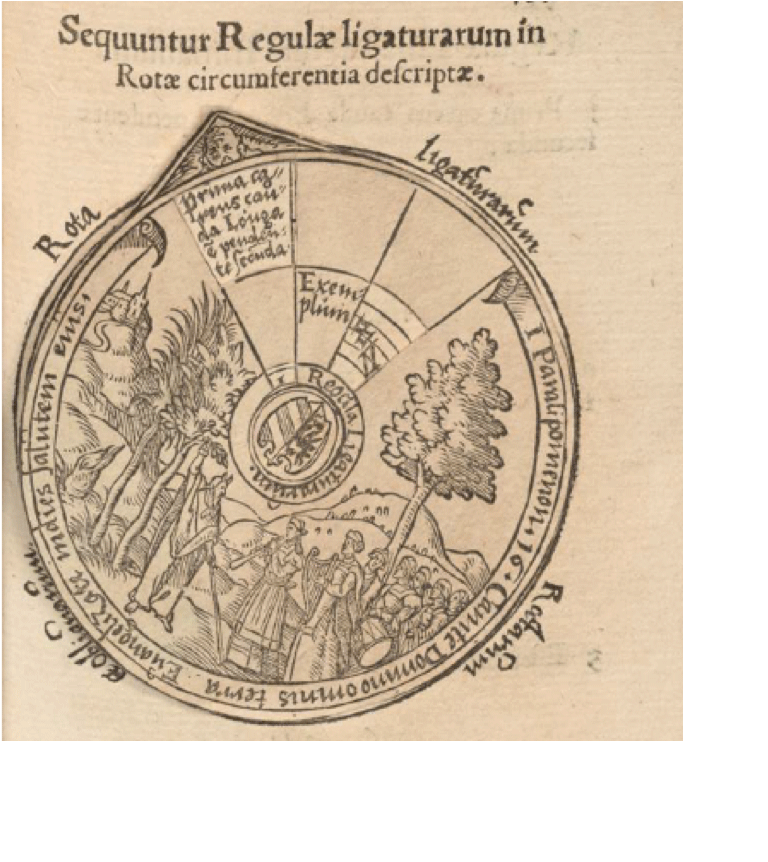
The two remaining volvelles in Wilfflingseder’s text aid in determining values in augmentation (on page 323) and diminution (on page 324).[6]


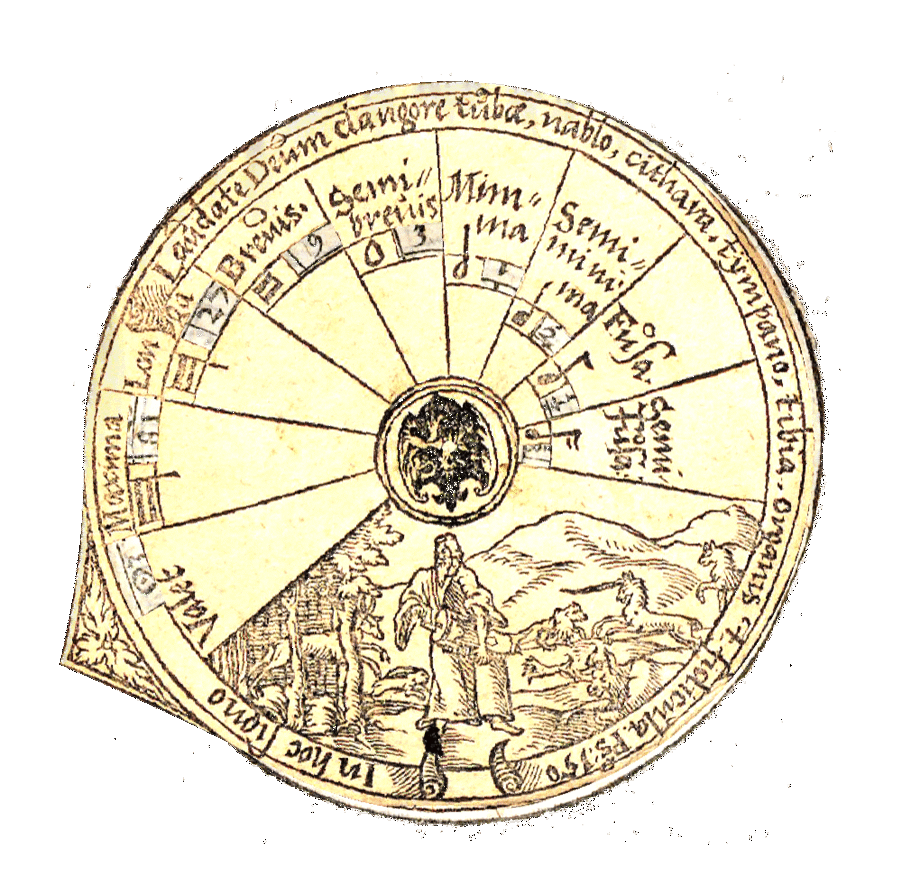
Opportunities to see other copies of Wilfflingeder’s Erotemata in libraries in Glasgow and London provided me with more parts to complete the puzzles, as well as some surprises that led me to propose further steps, one of which is to examine the existing books for signs of ownership and use, and the other for circling back to earlier texts that may have been models for musical wheel charts.
The Glasgow copy belonged at one time to John Stafford Smith, the composer of the music to our “Star Spangled Banner,” a bibliophile and one of the earliest collectors of Bach manuscripts. Apart from his signature on the title page and the date, 1778, the only other significant annotation is his labelling the instrument pictured on the outer wheel of the volvelle on page 323 as a lyra mendicorum or hurdy gurdy.
One of the two copies in the British Library belonging to Sir John Hawkins, also dated 1778, author of A General History of the Science and Practice of Music contains a pastedown with a list of some of the composers whose pieces are used in the Erotemata. Curiously, these are not German, but Franco-Flemish composers popular at the turn of the sixteenth century.
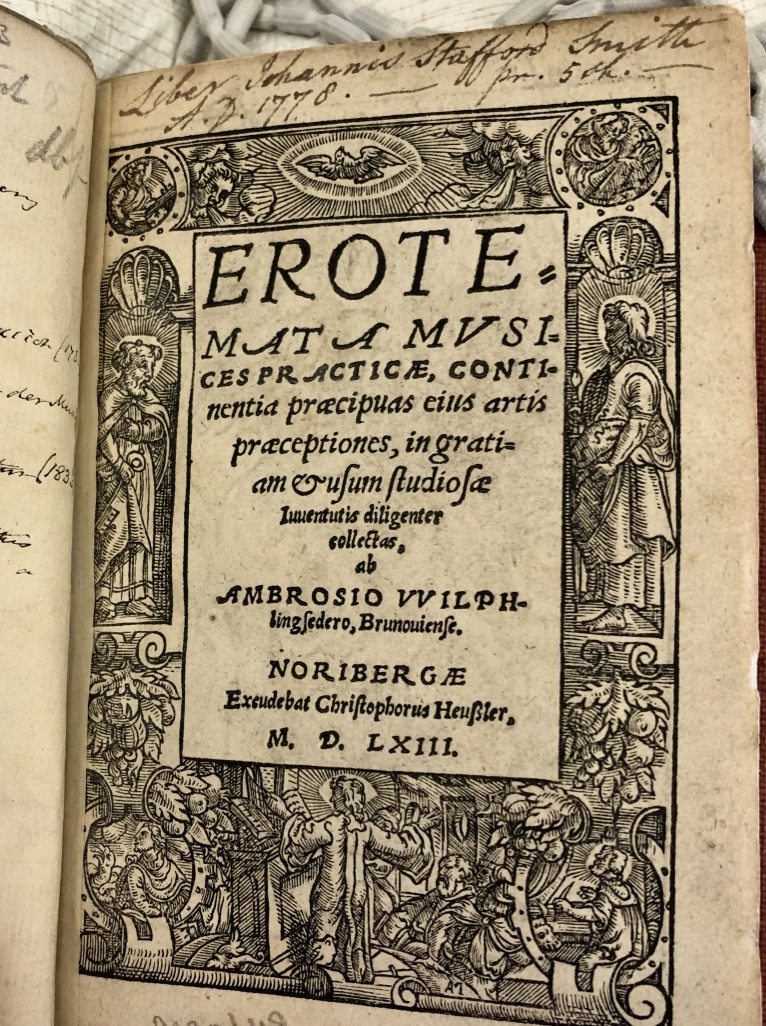
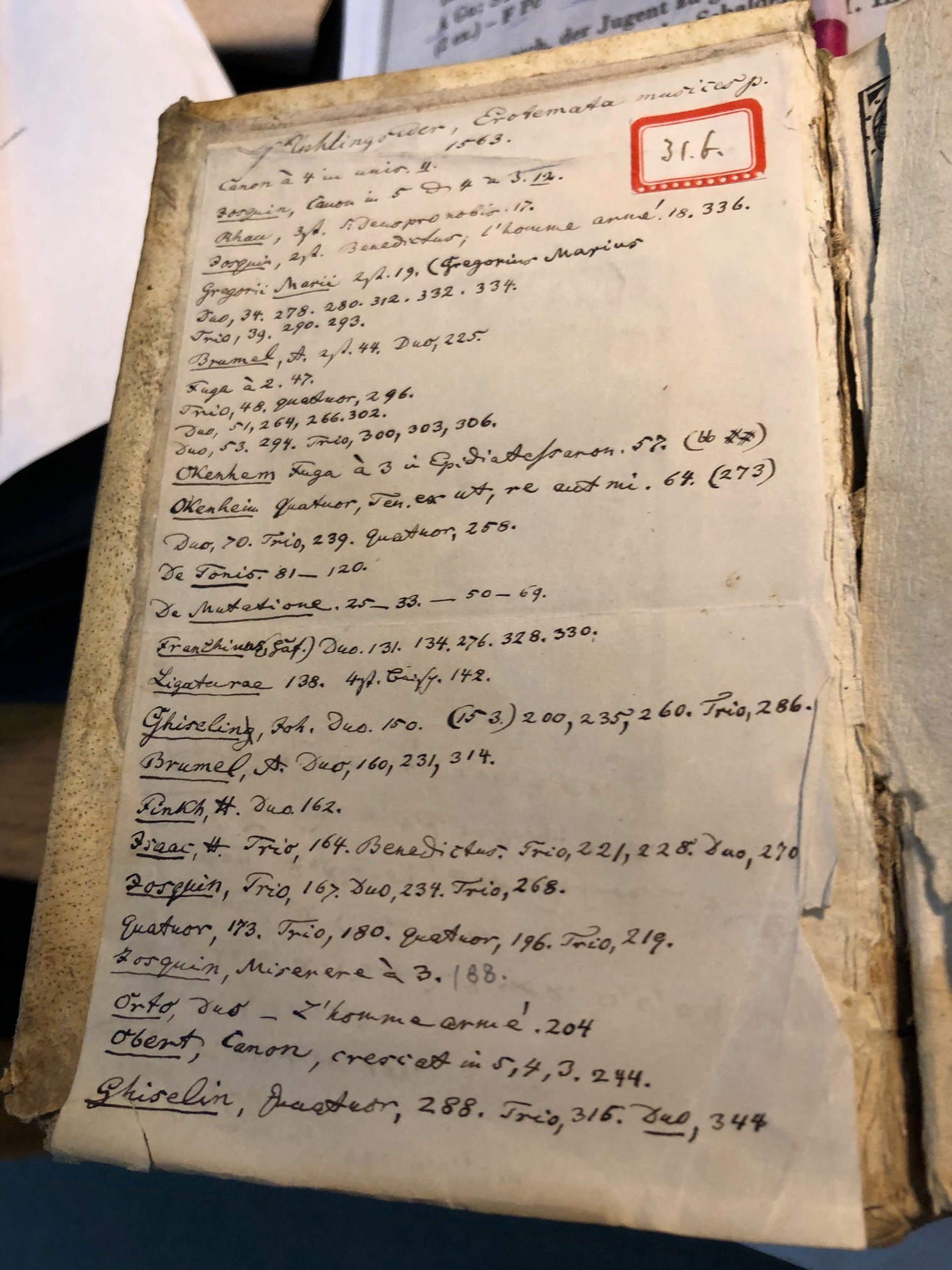
Conclusions
What do these volvelles reveal? A study of surviving copies of Wilfflingseder’s Erotemata suggest that these ephemeral mechanical devices appeared before the early years of the seventeenth century. These wheel charts were clearly meant to provide other ways of condensing tabular data and of learning, adding a tactile vector. Wilfflingseder and his printer-publisher Christoph Heussler were likely working in an environment in 16th century Nuremberg that encouraged novelty in the production of books. It is clear that these devices were fragile and likely to be damaged or destroyed in the course of use. Laurel Braswell-Means has written about “the vulnerability of volvelles” describing how the simpler ones are more likely to survive, while others with more numerous and delicate disks are less fortunate and strew the volvelle graveyard. [8] Determining survival were strength of materials, skill of craftsmen, frequency of use or abuse, and the chance fortunes of later manuscript history.
The presence of volvelles in the musical context can be seen as interactive mnemonic aids for learning music. Their use of the circle as a template may also signal a shift away from the vocal conceptualization of musical space toward an instrumental one that displayed the musical structure of the circular octave.
NOTES
1. See Suzanne Karr Schmidt, Interactive and Sculptural Printmaking in the Renaissance (Leiden and Boston: Brill, 2018), 240-44.
2. Michael Dodds From Modes to Keys in Early Modern Music Theory is under contract with Oxford University Press. Dodds, Daniel Muzzulini, myself and others will present further materials on a panel at the 2020 Annual Meeting of the Renaissance Society of America.
3. In those presentations, I discuss the life and career of this little-known pedagogue and theorist and another of his publications, written for his school in Nuremberg, one of the first music theory textbooks written in German, intended primarily for young learners.
4. See Susan Forscher Weiss, “Disce manum tuam si vis bene discere cantum: Symbols of Learning Music in Early Modern Europe”, Music in Art XXX/1–2 (2005): 35-74 and “The Singing Hand” and “Steps to Singing” in Writing on Hands: Knowledge and Memory in Early Modern European Culture, ed. Claire Richter Sherman (The Trout Gallery, Dickinson College, with the participation of The Folger Shakespeare Library, Seattle: University of Washington Press, 2001), 35-45, 174-83.
5. Penny Gouk, The Ivory Sundials of Nuremberg, 1500-1700 (Cambridge: Whipple Museum of the History of Science, 1988).
6. I am indebted to Ursula Korber at the Staats- und Stadtbibliothek Augsburg for photographing their two copies one containing intact volvelles and one with missing wheels.
7. I wish to thank my colleague Nathan Scott, Senior Design Instructor in the Department of Mechanical Engineering Whiting School of Engineering at Johns Hopkins, for animating this volvelle.
8. Laurel Braswell-Means in Manuscripta XXXV/1 (1991): 43-54.
Thanks to Paul Espinosa, Director of the George Peabody Library, and to Sasha Novack and Nathan Scott for their work on the animations.
